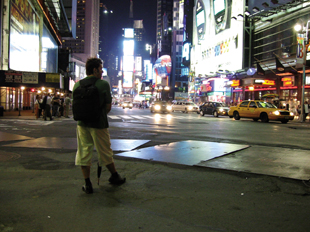Hack 30 Street Shooting at Night
| < Day Day Up > |
| Because of their compact size , pocket digicams are excellent street-shooters, enabling you to capture the grit and the glory of urban life at nightthat is, if you know how . When you sit back and look at your travel shots, do you ever feel like you're shooting the same thing over and over, and only the locations change (same boring group shots, blurry bus scenes through the window, and yet another statue)? One of the best ways to inject life into your photography is to grab your camera and hit the streets ...on foot . Now, I'm not talking about raw photojournalism or anything dangerous. Every major city in the civilized world has a good part of town and a bad one. Lace up your sneakers and go to the friendly part of town. My favorite time to shoot on the streets is from about an hour before twilight until darkness . Generally speaking, there's lots of activity at this time, and the building lights come on when there is still some color left in the sky. It's a magical setting that's perfect for photography. But if you want to capture that magic, you have to turn off your flash. This is rule number one for interesting street photography. Not only does the flash draw way too much attention to your shooting, but it also kills the shots. The possible exception is using Nighttime Flash mode [Hack #29] , but for most of your street shooting, leave the flash off.
Figure 3-2. The Chrysler Building As the light goes down, however, your exposures will get longer, which means you have to look out for camera shake. Here are a few ways to combat shake so you get crisp images, even in low light:
You can go up to 400 if you need to, but you will have more noise in your shots at the higher rating. Often, this isn't a big problem for street shooting, because the gritty look seems to work with this type of subject material. Generally speaking, though, don't increase your ISO setting any more than you have to.
You'll be surprised at what a difference this can make. Push your body weight against the building and lock your elbows against your body. Squeeze the shutter button; don't punch it. Your shots will be much sharper.
By having a pocket tripod, every newspaper stand, guard rail, and building step becomes a possible shooting surface. Simply place the tripod on a suitable flat area or strap it to a pole, and then enable the self-timer. The timer will trip the shutter without jarring the camera. This technique is particularly good for shooting nighttime monuments, buildings, and bridges that require lots of image sharpness. Now that you have some good ideas for how to shoot on the street, what do you shoot? People are often great subjects on the street, especially when they are interacting with others. If your camera has a variable-angle LCD monitor, you can hold your camera down at your waist and follow the action through the LCD. This draws less attention to you, because it isn't obvious that you're taking pictures. Another advantage to these types of adjustable viewfinders is that they make it easier for you to lower or raise the camera angle, bringing a fresh perspective to your images. For example, try putting the camera down on the ground. Then, raise it up over your head and look at the world from above. If you're shooting at slow shutter speeds, try to take the picture when the subject has paused for a brief second. That way, you'll get less blurring due to movement in the shot. If you plan on publishing your pictures, you should get a model release if the subject is recognizable (usually, if his face is discernible) in the photo. With model release in hand, identify yourself as a serious amateur photographer and offer to send a copy of the picture via email (and follow through). Many people will give you permission to use the shot if they like the way they appear on your camera's LCD. If you do get a release, you can then enter the image in photo contests or publish it.
Street scenes with buildings and other structures also make interesting images, especially if they're shot at twilight when the sky still has color and the street lights have just illuminated. Finding a flat surface on which to rest your camera and using the self-timer to trip the shutter is a great way to capture sharp shots, even in low light. A pocket tripod is perfect for these types of pictures. If there are cars passing through the composition, you'll get the added benefit of trailing headlights and taillights. People moving about might blur, but this isn't necessarily a bad thing. They can add to the feeling of activity and give your picture energy, as shown in Figure 3-3. Figure 3-3. Street shot in New York's Times Square Keep in mind that buildings constructed in the U.S. after December 1, 1990, are protected under copyright law, and you might need permission to publish the picture. Who would have ever thought that you might need a model release for a building? But many of the really interesting structures were erected long before that law went into effect. You still have lots to shoot without worrying about permission. So, next time you're traveling, for business or pleasure , remember to take your camera out for a walk. Play with a variety of angles, try photographing moving cars and people at slow shutter speeds, and see if you can capture that impressive building at twilight just as its lights have gone on. You'll add a new dimension to your slideshows that's bound to impress your viewers . |
| < Day Day Up > |
EAN: 2147483647
Pages: 161
